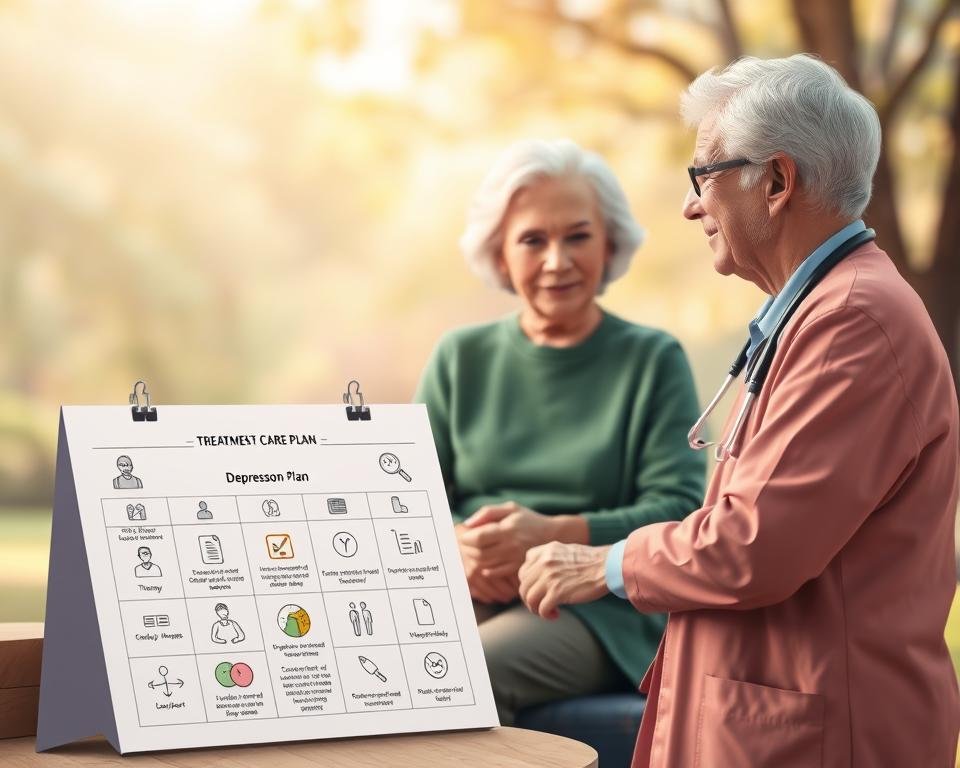“There is no greater agony than bearing an untold story inside you.” – Maya Angelou’s words remind us that unaddressed emotional struggles, like those tied to mental health in later life, demand attention and care.
Many assume low mood or withdrawal is just “part of getting older.” This couldn’t be further from the truth. While aging brings challenges, persistent sadness or loss of interest in daily life often signals a treatable medical condition. Research from the National Center for Chronic Disease Prevention shows roughly 4% of adults aged 70+ experience these symptoms.
Physical health changes, chronic pain, or isolation can heighten risks. But silence and stigma often prevent older adults from seeking help. Recognizing warning signs early – like sleep changes, fatigue, or unexplained aches – opens doors to effective solutions.
Key Takeaways
- Persistent low mood in older adults is a medical concern, not a normal part of aging.
- Approximately 4% of individuals aged 70+ experience diagnosable symptoms.
- Chronic health issues and social isolation frequently contribute to risks.
- Treatment options are available and can significantly improve quality of life.
- Early recognition of warning signs leads to better outcomes.
Understanding this topic isn’t just about awareness – it’s about empowering yourself or loved ones to seek support. Let’s explore how to identify red flags and navigate proven strategies for healing.
Understanding Depression in Seniors
When life feels heavy for weeks or months, it’s more than just a rough patch. For older adults, lasting emotional pain often reflects a medical condition needing care – not an inevitable side effect of aging. Let’s unpack what this means and why myths about aging can delay healing.
What This Means for You
Clinical depression isn’t occasional sadness. It’s a persistent mood disorder that disrupts daily life. You might lose interest in hobbies, struggle to sleep, or feel disconnected from loved ones. The National Institute of Mental Health notes it may also worsen chronic pain or fatigue, creating a cycle that’s hard to break alone.
Dispelling Common Myths
One dangerous myth? “Feeling blue is normal after 65.” Research from the American Psychological Association shows this belief prevents 70% of affected individuals from seeking help. Another misconception: “Treatment won’t work at this age.” Studies prove therapy and medication are just as effective for older adults.
For example, Martha, 78, thought her fatigue was “just aging.” After six weeks of counseling, she reconnected with her book club and gardening group. Stories like hers highlight why early action matters. Recognizing changes in mood or energy opens doors to tailored support.
Recognizing Symptoms and Warning Signs
Spotting changes in behavior or mood can feel like solving a puzzle with missing pieces. Unlike younger individuals, older adults often show subtler signs that blend with typical aging. The CDC reports 20% of those over 65 experience physical symptoms masking emotional distress – a key reason many cases go unnoticed.

Emotional and Behavioral Indicators
Watch for prolonged disinterest in social activities or hobbies they once loved. You might notice increased irritability, unexplained guilt, or statements like “I’m just a burden.” The National Institute on Aging found 1 in 4 older adults with mood disorders withdraw from family gatherings yet insist they’re “fine.”
Other red flags include neglecting personal care or skipping medications. These patterns often last weeks, unlike temporary sadness after life changes. As one 72-year-old told researchers, “I stopped calling friends because pretending to be happy exhausted me.”
Physical Symptoms to Watch For
Unexplained weight loss or digestive issues often signal deeper struggles. Chronic headaches, slowed movements, or fatigue that persists after rest deserve attention. Studies show sleep disturbances – like waking at 3 AM daily – affect 35% of older adults with untreated mental health needs.
Key differences from normal aging? Persistent changes. Forgetting names occasionally is typical; forgetting to eat for days isn’t. If fatigue lasts over two weeks despite adequate rest, consider consulting a professional. Early recognition bridges the gap between struggle and effective treatment.
Risk Factors and Causes for Older Adults
Life’s later chapters often bring unique challenges that test resilience in unexpected ways. While aging itself isn’t a direct cause of emotional struggles, certain factors create a perfect storm for mental health concerns. Let’s explore what makes some individuals more vulnerable and how to address these triggers.
Underlying Health Conditions
Chronic illnesses like diabetes, heart disease, or arthritis don’t just affect the body—they shape emotional well-being. Research from healthdirect reveals that 60% of older adults with two or more chronic conditions experience mood-related symptoms. Pain, limited mobility, or medication side effects can drain joy from daily life. For example, managing Parkinson’s disease often involves balancing physical care with emotional support to prevent spiraling distress.
Impact of Social Isolation and Loss
Losing loved ones, retirement, or moving from a family home can fracture social connections. A Johns Hopkins study found that seniors facing bereavement have a 40% higher risk of developing prolonged sadness compared to those with strong support networks. Loneliness isn’t just fleeting—it alters brain chemistry over time, making it harder to seek help. Simple steps like weekly phone calls or community activities rebuild belonging.
Addressing these risks isn’t about avoiding life’s hardships. It’s about creating layers of care—medical, social, and emotional—to help navigate them. If your loved one faces mounting health issues or shrinking social circles, proactive support can rewrite their story.
Barriers to Seeking Treatment and Support
Imagine needing a life raft but refusing to grab it because someone once said “strong people don’t drown.” For many older adults, invisible barriers block the path to emotional wellness. Let’s explore what keeps support just out of reach – and how to bridge the gap.
When Shame Speaks Louder Than Pain
Nearly 60% of adults over 65 with mood conditions avoid treatment due to stigma, reports the National Alliance on Mental Illness. Many grew up when mental health struggles were whispered about or ignored. Comments like “You should handle this yourself” or “Therapy’s for weak people” echo for decades, silencing cries for help.
Misconceptions compound the issue. Some believe psychotherapy “takes too much ” or won’t address physical symptoms. Others fear antidepressants will change their personality. These myths crumble under evidence – studies show 80% of older adults improve with proper care.
Roadblocks Beyond Beliefs
Even when ready to seek help, practical hurdles arise. Rural areas often lack specialists trained in geriatric mental health. Transportation issues leave many housebound, while Medicare’s limited coverage for psychotherapy strains budgets. One 68-year-old shared: “I called three clinics – the earliest appointment was six months away. I gave up.”
Delaying care has real consequences. Untreated conditions increase suicide risks fourfold in adults over 75, per CDC data. Chronic pain worsens, isolation deepens, and recovery takes longer. But solutions exist – telehealth options now connect homebound individuals to therapists within days, not months.
Your mental health matters more than outdated stereotypes or logistical headaches. Local Area Agencies on Aging often provide low-cost counseling referrals. Senior centers increasingly host support groups. Every minute spent overcoming these barriers buys back – for joy, connection, and peace.
Treatment Options for Depression in Seniors
Finding the right path to emotional wellness can feel overwhelming, but effective solutions exist. Modern approaches blend science with compassion, offering hope even when struggles feel unshakable. Let’s explore proven strategies that adapt to your unique needs.
Antidepressant Medications and Their Role
Medications like SSRIs or SNRIs often help balance brain chemistry. Doctors typically start with low doses for older adults to minimize side effects. Common options include sertraline or venlafaxine, which studies show improve mood in 60% of cases within 6-8 weeks.
Watch for interactions with other medications. Blood pressure drugs or pain relievers might require dosage changes. Regular check-ins with your provider ensure treatments stay safe and effective.
Psychotherapy and Alternative Interventions
Cognitive behavioral therapy (CBT) teaches practical skills to reframe negative thoughts. Group sessions or family therapy rebuild connections strained by illness. Research shows combining talk therapy with medication helps 75% of individuals see improvements.
Gentle exercises like tai chi or walking groups address both physical and emotional problems. Art therapy or volunteering also spark joy and purpose. One 81-year-old found weekly watercolor classes eased her loneliness better than any pill.
Remember: Your journey matters. Work with professionals to create a plan that fits your lifestyle. Small changes today can rewrite tomorrow’s story.
Tailoring Treatment to Your Unique Needs
What if your treatment plan fit like a favorite sweater—comfortable, familiar, and uniquely yours? Older adults often juggle multiple health things, from arthritis to cancer, requiring care that adapts to their specific story. A one-size-fits-all approach rarely works when managing emotional wellness later in life.

Considerations for Medication Management
Doctors often start with lower doses for older adults. Why? Metabolism slows with age, and interactions with other drugs—like those for cancer or heart things—need careful monitoring. Healthdirect research shows personalized dosing reduces side effects by 30% compared to standard protocols.
Regular blood tests help track how your body processes medications. Don’t hesitate to mention unusual symptoms—even minor changes matter. As one pharmacist notes, “Adjusting a pill by 5mg can mean the difference between relief and frustration.”
Benefits of Cognitive and Behavioral Therapy
Talk therapy isn’t just venting—it’s skill-building. CBT teaches practical tools to break negative thought cycles. Studies show 45% of participants report better sleep and engagement in activities within eight weeks.
Pair therapy with structured routines. Morning walks or weekly art classes create anchors of joy. These activities rebuild neural pathways dampened by prolonged stress. One 74-year-old found gardening sessions more effective than her prescription—“Watching seeds grow reminded me I could too.”
Facing stigma? Start small. Share concerns with a trusted nurse or pharmacist first. Every conversation chips away at outdated beliefs. Remember: Your needs matter, and solutions exist to match them perfectly.
Depression in Seniors in the Context of Overall Health
Your body and mind aren’t separate entities—they’re partners in every breath you take. When physical health falters, emotional well-being often follows. For older adults, this connection becomes especially clear. Conditions like diabetes or sudden weight shifts don’t just strain the body—they can cloud joy and motivation too.
Integrating Physical and Mental Health Care
Research shows 65% of older people with diabetes also experience mood challenges, according to the National Institute on Aging. Unintended weight loss or gain often signals deeper struggles—like nutrient deficiencies or hormonal imbalances that worsen emotional lows.
- Chronic illnesses increase inflammation, which studies link to depression older adults may face
- 40% of those with heart disease report persistent sadness or anxiety
- Team-based care models improve outcomes by 50% compared to isolated treatments
Coordinating between doctors, therapists, and nutritionists ensures no symptom gets overlooked. Simple steps matter: A pharmacist might adjust diabetes meds causing fatigue, while a therapist addresses sleep issues.
Remember—managing overall health isn’t about perfection. It’s about creating a support net that catches both physical and emotional needs. You deserve care that sees the whole picture.
The Role of Family, Friends, and Community Support
Support networks act as lifelines when storms roll in. For older people navigating emotional challenges, a simple “How can I help?” from loved ones often lights the path toward healing. Research shows 80% of people experience depression report improved outcomes when surrounded by engaged communities.

How Loved Ones Can Help
Notice subtle shifts first. Did weekly phone calls become monthly? Has their favorite hobby collected dust? These changes might signal deeper struggles. A University of Michigan study found 1 in 3 older people hide symptoms from doctors but share clues with family.
- Offer concrete help: “Let’s walk to the park Tuesday” works better than vague offers
- Attend medical visits to ensure concerns get addressed
- Create low-pressure social moments – shared meals or puzzle nights rebuild connection
Isolation fuels emotional pain. Weekly grocery trips or coffee dates become therapeutic rituals. “My daughter’s 10-minute daily calls became my anchor,” shares Robert, 76. Community centers often host art classes or gentle yoga – perfect icebreakers for rebuilding social bonds.
Remember: You’re not fixing problems. You’re holding space for healing. Small gestures – watering plants together or reminiscing over photo albums – remind older people they’re valued. As one therapist notes, “Recovery begins when someone feels truly seen.”
Managing Co-occurring Conditions and Complications
Navigating multiple health challenges can feel like untangling a knot—each thread affects the others. When medical conditions like diabetes or heart disease overlap with emotional struggles, finding the right treatment requires careful coordination. Clinical guidelines emphasize that 60% of older adults with mood-related signs depression show have at least two chronic physical illnesses complicating care.
Coordinated Care Strategies
Your care team should work like a symphony—each specialist playing their part. Regular communication between doctors, therapists, and pharmacists prevents conflicting treatments. For example, blood pressure medications might need adjustment if fatigue worsens mental illness symptoms.
Prioritize providers who share electronic health records. This ensures everyone sees the full picture. As one geriatric nurse explains, “A 10-minute call between specialists often solves what weeks of appointments miss.”
Monitoring and Adjusting Treatment Plans
Health evolves, and so should your plan. Monthly check-ins help track how new medical conditions or medications impact emotional well-being. Simple tools like symptom journals reveal patterns—maybe joint pain flares trigger low motivation.
Don’t hesitate to ask for changes. If a drug causes drowsiness, your doctor might switch to a daytime dose. Research shows tailored adjustments improve outcomes by 40% compared to static plans. Remember: The right treatment today might need tweaks tomorrow.
Conclusion
Hope grows when we nurture it—even in life’s later seasons. Persistent sadness isn’t a normal part of aging, and effective treatments like therapy or antidepressant medicines can reignite joy. Recognizing risk factors—from health changes to isolation—helps you act early.
If you notice shifts in mood or energy, talk to family friends or a doctor. Studies show 80% of older adults improve with care tailored to their needs. Coordinated efforts between medical teams and community groups create safety nets for healing.
Remember: You’re never “too old” to feel better. Small steps—a weekly call, a walk with neighbors—rebuild connections that shield against risk depression. Treatment plans evolve with you, blending antidepressant medicines with activities that spark purpose.
Your story isn’t over. With support from family friends and professionals, brighter days await. Take that first chat today—help is here, and recovery is within reach.
